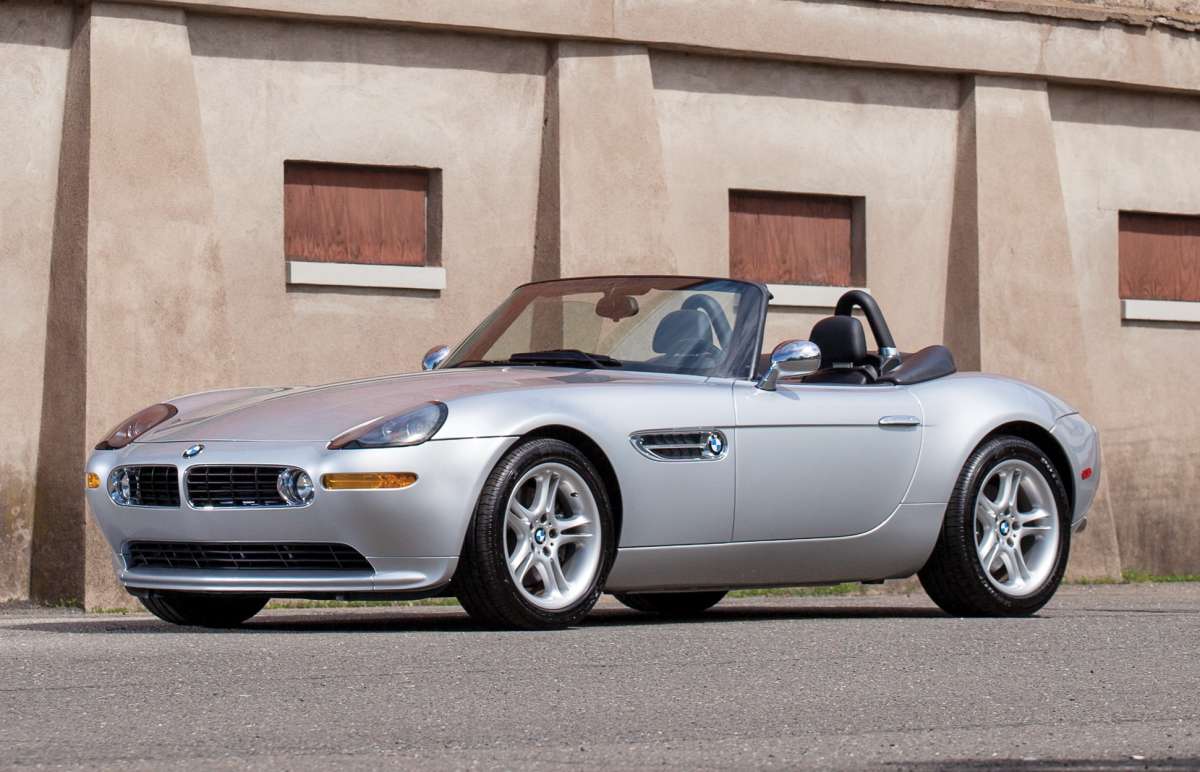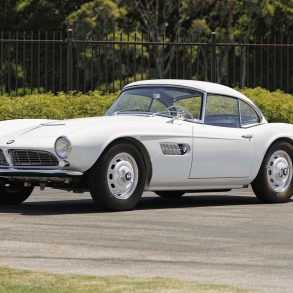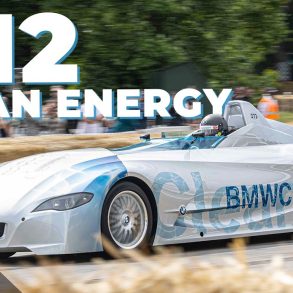Ritzy and opulent, grand tourers offer the most accomplished automotive experience, granting a balance of sheer power, luxury, and comfort. For ones with a greater desire for freedom, each journey gets even more majestic without a roof. Nearly five decades after the 507 ambitiously entered the US market, BMW saw its chance to present its vision of a true grand touring convertible. In the zenith of retro-modern design, the Bavarian company offered the BMW Z8, a modern homage to its most exquisite classic.
Finally, BMW had an open-top grand tourer to come after the legendary 507 and match contemporary competition from Italy, Britain, and Germany. This is a story about V8 grand touring done the Teutonic way.
BMW Z8 featured in James Bond ‘The World is Not Enough’ (1999) Source: Cars & Movies
Background
The car that influenced BMW to create the Z8 was arguably one of the most beautiful silhouettes that ever came from Münich. The BMW 507 was envisioned as a luxurious grand touring convertible primarily built for the blossoming American market in the late 1950s.

The 507 was a brainchild of Max Hoffman, an influential Austrian-born American entrepreneur who built his fortune and reputation as an importer of European luxurious cars in the 1950s. Hoffman himself suggested Mercedes-Benz should convert the W194 race car into the 300SL Gullwing and Porsche to build the iconic 356 Speedster. With the BMW 507 and 503, Hoffman aimed to fill in a gap between the 300SL Roadster and the less expensive British marques.
Its carefully dosed use of chrome decor and swooping lines put it on par with the most exquisite cars of its era, but none of it was enough to save BMW from a financial dire strait. On the contrary, the company nearly went bankrupt as a result of astronomical building costs leaving BMW losing money on each example produced.

A drastic increase in production costs reflected in a proportional increase in the sticker price. A far cry from Hoffman’s predictions, the 507 flopped with just 252 examples produced between 1955 and 1959 run.
Fast forward a couple of decades, BMW rapidly progressed to become one of the most recognizable brands in the world, while the 507 established itself as the pinnacle of post-war BMW and a highly regarded collector’s car.
Development of the BMW Z8
The 1990s were the times when numerous leading brands turned to their past to reinterpret it for the 21st century. At the same time, BMW officials turned to the company’s roots, wondering how the 507 would evolve had BMW managed to conquer North America in the 1950s.
Chief designer Chris Bangle wanted to explore this what-if scenario with a series of Z07 concepts. These retro-futuristic design studies envisioned a roadster and a bubble-top coupé taking immediate inspiration from the 507. Even its name inevitably pointed to the archetypal BMW open-top cruiser.

In parallel with the concepts, BMW already planned a restricted number of production cars, testing the waters at the 1997 Tokyo Motor Show. Followed by a positive reaction of the automotive public, BMW proceeded with the development of the flagship cruiser. Being the range-topping offering in the Z roadster family, the roadster was christened Z8.
The production version of the car debuted on the big screen as James Bond’s car in ‘The World Is Not Enough’. There, Pierce Brosnan’s final rendition of the 007 cemented BMW’s intention to unveil and market the Z8 as an instant classic. The Z8 was BMW’s third official Bond car, and it was by far the most appropriate one, serving as a climactic follow-up to the Z3 and the E38 750iL featured in GoldenEye and Tomorrow Never Dies.

Needless to say, a limited run of 5,703 examples was sold from 2000 to 2003, with 2,543 of them ending up on the North American market.
Construction
The BMW Z8 was built using a lightweight aluminum space frame, enabling substantial structural rigidity for a roadster combined with low weight. Without the hardtop, the car weighed 3,494 lb, compared to 3,554 lb with the top on.
The frame was made of extrusion-pressed beams with almost 1,000 rivets and around 190 ft. of fused welding seam (MIG) to hold the frame and the body panels together.

Most of the production was completed at BMW’s Dingolfing plant, while some parts like the plastic front and rear bumper were made at the Landshut factory. The final assembly was carried out at a dedicated production line by a team of skilled employees in 31 assembly steps.
Body
The all-aluminum body of the Z8 designed by Henrik Fisker was so enamored with the idea of creating this car that he zealously worked on it over his summer holiday, penning the design of the production car.

The Z8 didn’t differ much from the Z07 concept, yet it was retouched to better suit a production car. Compared to the concept, the Z8 lost two distinctive features, the 1950s racing-inspired helmet fairing and the double bubble for the removable hardtop. The former feature had to be changed to allow for easier movement of the soft top, while a single curve of the hardtop suited the lines of the Z8 better.

The wide nostril grilles were the defining feature of the 507 and in modern Z8 guise they were given a perfect 2000s makeover, and so were the chrome gills on the front fenders. In true flagship manner, the Z8 stood out from the rest of the BMW range while simultaneously carrying the company’s DNA.

Interestingly, the Z8 didn’t have any badging apart from the roundels in the front, on the trunk lid, and inside the fender gills, just like on the 507. The clean rear lights completed the retro-modern look, but lights carried a unique technology hiding behind the lenses. Instead of traditional light bulbs, the Z8 had neon turn signals and rear lights, with Xenon headlights in the front.
In addition to factory finishes, the customers who wanted more from their Z8 could personalize their car through the BMW Individual program. Rare examples, just 19 of them, sported a bi-color exterior finish: eleven cars sported cream-on-Stratus silver, seven were finished in silver-on-black and just one in Carbon Black/Silver with light silver grey interior.

Interior
Just like the body, the interior also drew on the 1950s, alas it didn’t mirror the 507’s massive round instruments positioned directly behind the steering wheel.

On the contrary, interior designer Scott Lempert moved the instrument cluster to the middle of the car, slightly tilting it towards the driver’s side. The dashboard was finished in either brushed aluminum or black piano lacquer, emulating the look of are metal panels usually found in 1950s automobiles. The central placing on the instruments was there to free the driver of any distractions from the roads ahead, even if it sometimes meant breaking the speed limit.

The perfectly proportioned three-spoke leather steering wheel was a beautiful reimagination of 1950s design with subtle art deco inspiration. In efforts to keep the interior simplistic and uncluttered, BMW took special care in allocating the commands and giving them unique design. That being said, not a single button or a knob is shared with another BMW from the period and each is designed to fit the retromodern theme. Interestingly, the Z8 had a starter button positioned above the ignition lock, quite a modern feature for a retro interior.

As the only feature which couldn’t be designed in lieu of the rest of the interior, the Multi-Information Radio unit has been cleverly hidden away behind a retractable color-coded panel below the climate controls. Finally, Lempert completed the interior design by placing the Z8 badge right between the headrests.

Engine
Being the ultimate car in the Z series, the Z8 required a special engine. It was the all-aluminum 395 horsepower S62 V8 taken from the E39 generation M5. The engine was a high output variant of the M62 V8 which underwent a series of revisions from BMW Motorsport engineers,

The upgrades transforming the potent M62 into one of the most cherished BMW M engines included nodular cast iron hollow camshafts, semi-dry sump lubrication, eight electronically actuated individual throttle butterflies, larger dual air intakes, and mass flow sensors.
Moreover, the S62 got dual-VANOS variable valve timing of both intake and exhaust valves, a heavy-duty duplex timing chain, and a Siemens Motronic MSS 52 engine control unit. The unit oversaw vital components of the engine including an LED tachometer warning zone and M Driving Dynamics Control enabling Normal and Sport throttle response.

The stroke and bore of the engine were increased from 82.7 mm to 89.0 mm and 92.0 mm and 94.0 mm respectively, giving the S62 the displacement of 4.9 liters and 394 horsepower at 369 lb-ft of torque. The engine produced peak horsepower at 6,600 RPM and maximum torque at 3800 RPM, while the rev limit was at 7000 RPM.
When the engine is first started, the tachometer’s warning zone (indicated by orange LEDs) begins at 4000 rpm. As the engine warms, LEDs are extinguished to lift the limit in increments of 500 rpm until the warning field begins at its normal 6500 rpm. The actual rpm limit is 7000.
Equipped with such a potent engine and with 6-speed manual transmission only, the BMW Z8 not only looked divine but had the performance to back up the heavenly design. Drivetrain-wise, the only thing that BMW Z8 didn’t inherit from the M5 was a limited-slip differential.
Given that the Z8 was powered by an M-engine, to a full-blown M car, the drive was softer and more amiable, but was far from boring. The 0-60 sprint took just 4.7 seconds and the top speed was electronically limited to 155 MPH, although there were rumors of a maximum velocity 180 MPH.

These numbers made clear that BMW brought something more than just a costly cruiser capitalizing on nostalgia because the Z8 was a car generously giving back to its driver. The Z8 was acclaimed for a balanced driving experience, and the handsome roadster package just animated the public to love it even more. It wasn’t a bona fide sports car, yet was engineered to give it all while on long indulging drives through the perfect scenery.
Suspension and Steering
To offer a balance between a sports car and a relaxed cruiser, the Z8 utilized McPherson struts at the front and a multi-link rear with twin-tube gas shocks in the front and in the back. In efforts to shed weight and further refine the driving feats, gentle and lightweight aluminum was used for constructing the suspension set-up.
As previously mentioned, the Z8 wasn’t meant to be an M-car, even though it had an S-coded V8, so the suspension was soft and engineered for cruising and spirited driving rather than shedding seconds on the tracks.
As a pioneering feature on a V8-powered BMW, the Z8 had rack-and-pinion steering with a variable ratio. The steering was set to go hand in hand with the character of the car and as such, it was more suitable for light and carefree journeys. Some journalists found the steering to be too imprecise, misjudging the Z8’s main purpose.
Brakes, Wheels and Tires
For the Z8, BMW needed capable brakes, but necessarily sporty ones used on the M5. So, the brakes were borrowed from a range-topping sedan, the V12-powered 750 iL. The ventilated rotors measured 334 mm in the front, 328 mm at the rear, and stopping power was ensured via two-piston front calipers in the front and single-piston calipers in the rear.

The Z8 had a single slightly concave five-double spoke wheel design measuring 18X9 in the front and 18X9 in the back. Paired with the wheels were 245/45R-18W front and 275/40R-18W run flat tires, first of its kind on a European production car.
Alpina Roadster V8
Whereas some elements of the BMW Z8, most notably the engine, were clearly performance-oriented, it was still a step closer to an old-school grand tourer. However, some potential buyers found it too engaging, particularly due to the fact that it only had a manual transmission.

To address this, BMW partnered with Alpina to produce a limited run of 555 cars in 2003, the last production year of the Z8. Out of a total production run, 450 went to US soil where they were sold through BMW’s official dealership network.
The car was comprehensively revised to provide a more delicate grand touring experience. Instead of the M5-derived S62, the Alpina Roadster V8 sported a modified 4.8-liter M52 producing 375 horsepower, less than the Z8, but the torque output was increased to 383 lb-ft, granting more relaxed power delivery. Still, Alpina raised the top speed limit to 161 MPH, signifying that the downtuned Z8 could still provide a thrilling ride if needed.

The gearbox of the Alpina Roadster V8 was a 5-speed BMW Steptronic exclusively and it came with push-button shifters integrated into the modified steering wheel. The dashboard was also revised with custom Alpina dials and a new instrument, a digital gear indicator positioned right behind the steering wheel. The interior also used more delicately grained Nappa leather and introduced new color options.
Alpina made the suspension softer and the run-flat tires on 18-inch wheels were dropped in favor of 20-inch Alpina five-multispoke wheels with conventional tires with softer sidewalls, thus completely redefining the driving experience.

Both inside and out, Alpina redefined the Z8 into a true European grand tourer for the American roads and this time on purpose, the production numbers were much closer to the 507’s.
Legacy
In spite of their similarities, the 507 which held high hopes for a developing small company BMW was and the Z8 of the automotive giant BMW we know today were two fundamentally different cars.

From the start, BMW produced the Z8 to be a desirable collector car. Each example came with ample equipment, a guaranteed 50-year spare part production run, and a matching hardtop as standard.
With the Z8, BMW didn’t offer just a car, but an experience for itself; US-based customers were granted an exclusive Z8 Driving Experience at BMW’s Performance Center Driving School in California and each owner got an individually numbered booklet covering the Z8’s creation from initial drawings to the production stage of the exact cars, complete with paint and upholstery samples. Also, BMW offered a scale car replica of each individual Z8 produced.

Given that the Z8 still commands six-figure prices, often above the original MSRP of $128,000 means only one: BMW had done it right. This mega roadster is a perfect drivable modern classic balancing between a supercar and an elegant plush cruiser and it’s one of the most sought after BMWs today.
Apart from its collector car value, the Z8 holds an important role in BMWs history. Following the end of production in 2003, BMW started evoking its past more often, sometimes in the form of various homages in the past, or less obviously by adding subtle styling touches in its current cars. After all, BMW has so much to be proud of, even if it is a car that nearly became a swan song more than half a century ago.










